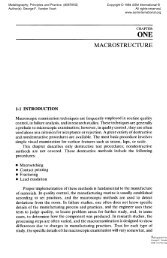Sample Chapter - asm iron and steel - ASM International
Sample Chapter - asm iron and steel - ASM International
Sample Chapter - asm iron and steel - ASM International
You also want an ePaper? Increase the reach of your titles
YUMPU automatically turns print PDFs into web optimized ePapers that Google loves.
© 2002 <strong>ASM</strong> <strong>International</strong>. All Rights Reserved.<br />
Metallographer’s Guide: Irons <strong>and</strong> Steels (#06040G)<br />
2 / Metallographer’s Guide<br />
The Unified Numbering System (UNS). Because of the<br />
confusion of different systems, a number of technical societies <strong>and</strong><br />
U.S. governmental agencies devised what is known as the Unified<br />
Numbering System. There is a UNS designation for each <strong>steel</strong><br />
composition, <strong>and</strong> it consists of a letter followed by five digits. The<br />
system fully incorporates the AISI/SAE system. For example, the<br />
UNS designation for AISI/SAE 1040 is G10400. The letter “G”<br />
represents the AISI/SAE plain carbon <strong>and</strong> alloy <strong>steel</strong>s. Other<br />
ferrous alloys have different letters, such as “F” for cast <strong>iron</strong>s <strong>and</strong><br />
cast <strong>steel</strong>s (cast <strong>steel</strong>s can also have the letter “J”), “D” for <strong>steel</strong>s<br />
with specific mechanical properties, “S” for heat- <strong>and</strong> corrosionresistant<br />
<strong>steel</strong>s, “T” for tool <strong>steel</strong>s, <strong>and</strong> “H” for <strong>steel</strong>s with<br />
enhanced hardenability. In this book, the AISI/SAE designations<br />
are favored only because they are, at the present time, more<br />
Fig. 1.1 Classification chart for <strong>steel</strong>s<br />
widely used than the UNS designations. However, in the reference<br />
tables in the Appendix, both designations are listed.<br />
In this <strong>Chapter</strong>, all systems are used where appropriate. For<br />
some <strong>steel</strong>s, it may be easier to use the AISI/SAE system, for<br />
others, the ASTM system. We first examine the way the <strong>steel</strong>s are<br />
classified simply by composition, using the AISI/SAE system.<br />
This system has been established for many years <strong>and</strong> is widely<br />
used in industry.<br />
Carbon <strong>and</strong> Low-Alloy Steels<br />
www.<strong>asm</strong>international.org<br />
The general category of carbon <strong>and</strong> low-alloy <strong>steel</strong>s encompasses<br />
plain carbon <strong>steel</strong>s, alloy <strong>steel</strong>s, high-strength low-alloy
















